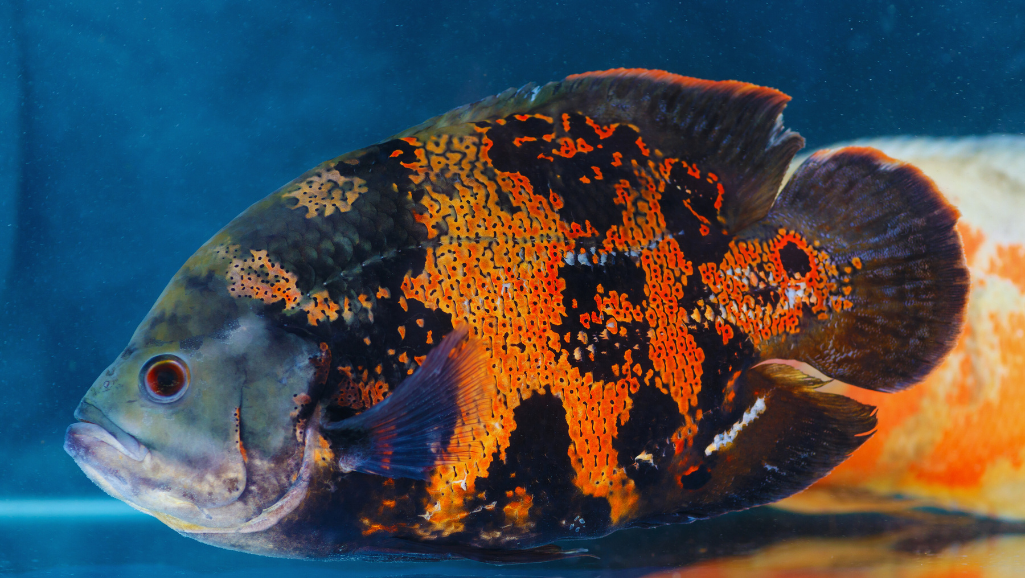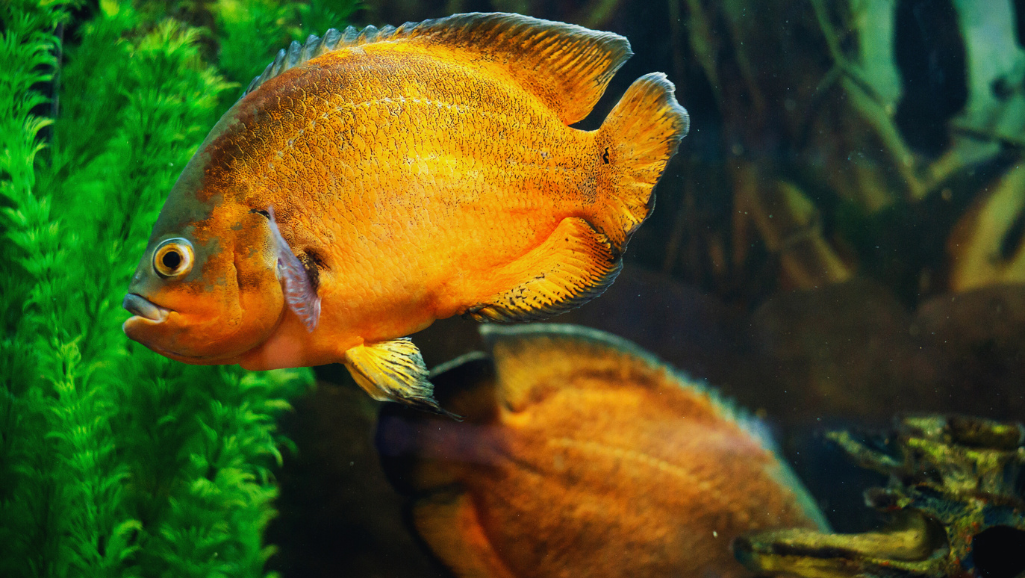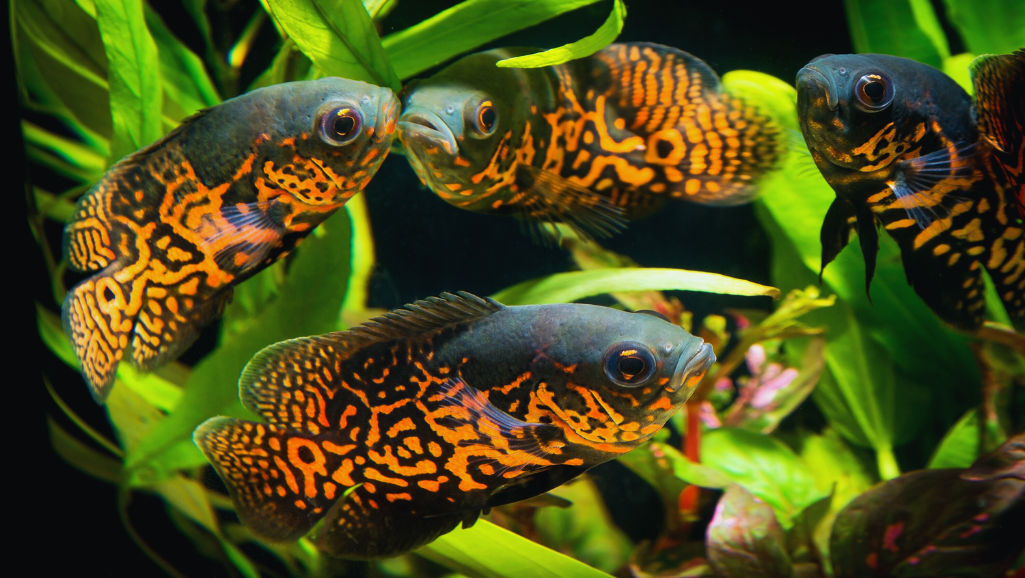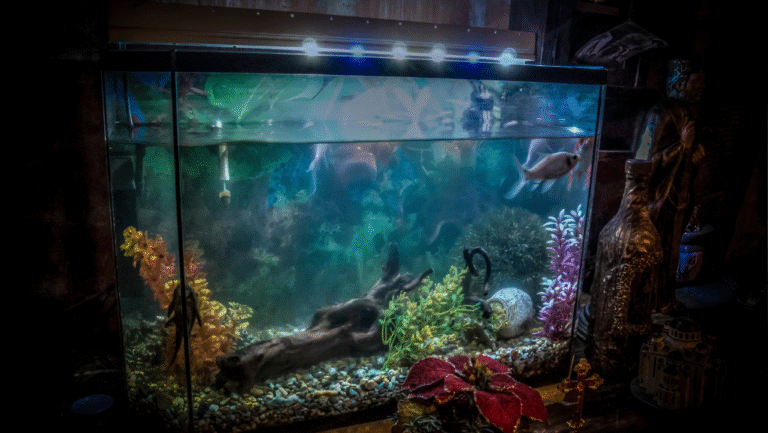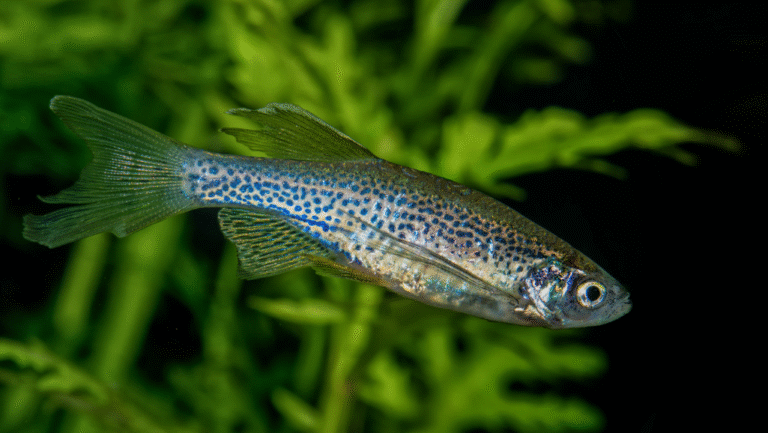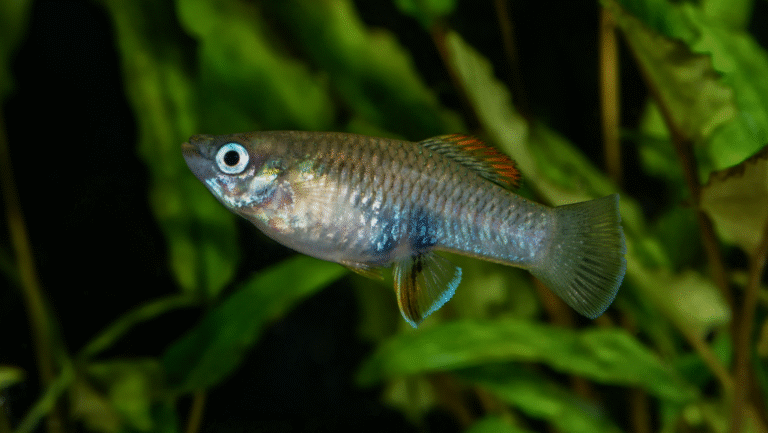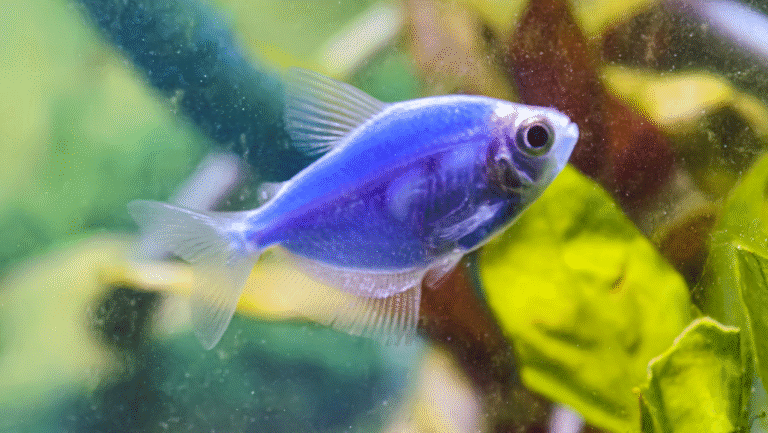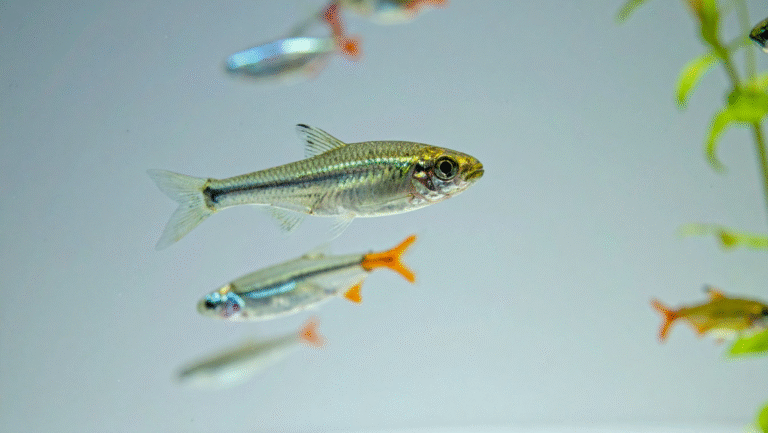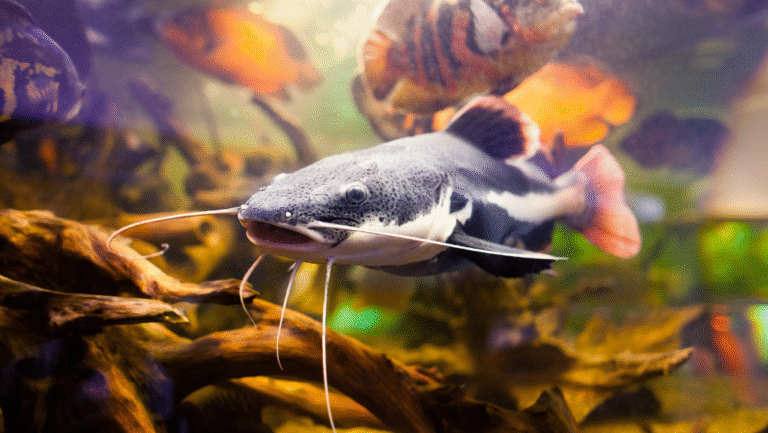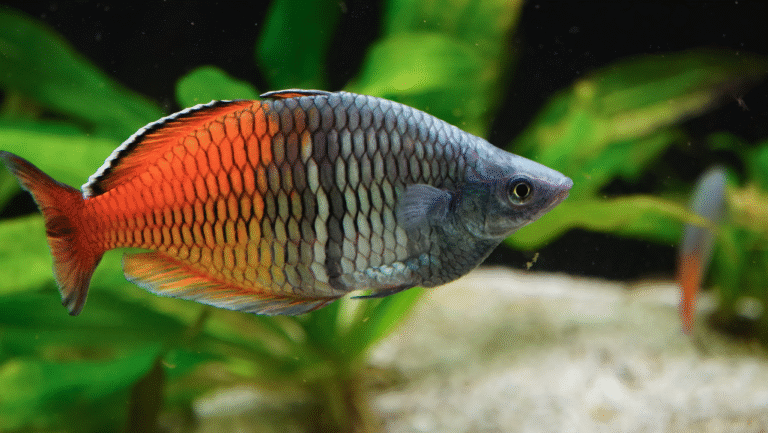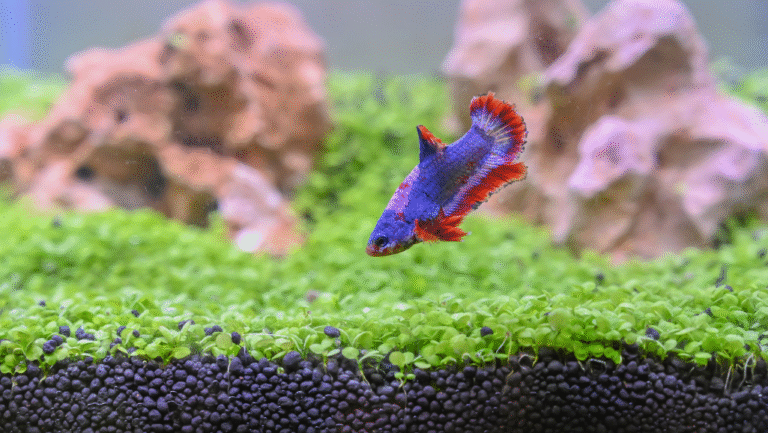The Tiger Oscar is a stunning freshwater fish loved by many. They come from South America’s Amazon River basin. Their bright orange-red spots on a deep blue body make them stand out.
These cichlids can grow up to 18 inches. Their size and unique personality make them a great choice for aquariums.
Tiger Oscars need a lot of space. They do best in tanks of at least 75 gallons. For a pair, 120 gallons is even better.
They like water between 74-81°F and a pH of 6.8-7.4. These fish are smart and can play with their owners.
However, they can be territorial and aggressive. They’re not good for community tanks. They might eat smaller fish. But with the right care, they can live 10-13 years, making them a great long-term choice.
Key Takeaways
- Tiger Oscars are large, colorful cichlids native to South America
- They require spacious tanks of at least 75 gallons
- These fish can grow up to 18 inches in length
- Tiger Oscars are intelligent and can recognize their owners
- They have specific water parameter needs and are territorial
- With proper care, Tiger Oscars can live 10-13 years
Introduction to Oscar Fish
Oscar fish, also known as Astronotus ocellatus, are amazing South American cichlids. They have become very popular in aquariums. These fish have a rich history and interesting traits that many people love.
Origin and Natural Habitat
Oscar fish come from the Amazon River basin. They live in slow-moving waters with lots of sunken branches and logs. These intelligent freshwater fish were first found by Louis Agassiz in 1831. Their home includes the Paraguay River, Rio Negro, and Parana River in South America.
Popularity in the Aquarium Trade
Oscar fish are loved for their beautiful looks and fun personalities. They are easy to care for, making them great for both new and experienced fish keepers. Here are some interesting facts about them:
| Characteristic | Details |
|---|---|
| Lifespan | 10-20 years in captivity |
| Size | Up to 33 cm in length |
| Weight | Approximately 1.1 kg |
| Tank Size | Minimum 152 liters (50 gallons) |
| Water Temperature | 23-27°C (77°F) |
Oscar fish are smart and can even recognize their owners. They love to eat from their hands. Their colors, from dark with yellow spots to albino, add beauty to any tank.
Physical Characteristics of Tiger Oscars
Tiger Oscars are striking freshwater fish known for their distinctive appearance. Their Tiger Oscar appearance is characterized by a splotchy pattern of bright orange-red over a deep-blue base color. This unique fish coloration makes them a standout in any aquarium setting.
When it comes to Oscar fish size, these aquatic beauties can grow quite large. Adult Tiger Oscars typically reach lengths of 12-15 inches, with some specimens growing up to 16 inches. Their substantial size contributes to their commanding presence in home aquariums.
The coloration of Tiger Oscars can vary among individuals. Some display vibrant, high-contrast patterns, while others might have more subdued hues. Factors such as diet quality and water conditions can influence the intensity of their colors. Tiger Oscars also feature large, expressive eyes rimmed with orange, adding to their visual appeal.
- Average lifespan: 10-20 years
- Adult length: 30-40 cm
- Average mass: 1.58 kg
- Growth rate: About 1 inch per month for the first 7-8 months
Tiger Oscars are just one of many Oscar varieties. Other popular types include Albino, Wild, Black, Red, Lemon, and Blue Oscars. Each variety showcases its own unique fish coloration, making the Oscar species a diverse and visually captivating group of freshwater fish.
Tiger Oscar Behavior and Personality
Tiger Oscars are unique in the world of freshwater fish. They show off their Oscar fish behavior and smart cichlid intelligence. These traits make them a favorite among fish lovers.
Intelligence and Interaction with Owners
Tiger Oscars are very smart, making them stand out in aquariums. They can recognize their owners and follow them around the tank. This earns them the nickname “water dogs.”
These intelligent cichlids are curious and love to watch their caretakers. Some owners even report their fish eating from their hands. But, it’s important to be careful because of their small teeth. This level of interaction is rare and shows how Oscars can form bonds with humans, like other smart freshwater fish.
Territorial Nature
Tiger Oscars are very territorial, especially in their aquarium space. Understanding this is key to their care. They like to change their tank decorations and substrate to fit their needs.
This territorial behavior affects who they can live with. Oscars do best with large, peaceful fish. Good tank mates include big Plecostomus and Neotropical Cichlids. This ensures a peaceful aquarium where everyone respects the Oscar’s space.
Ideal Tank Setup for Tiger Oscars
Setting up the perfect Oscar fish tank setup is key for these amazing freshwater giants. Tiger Oscars need lots of space and special conditions to live well in captivity. Let’s explore what makes their ideal home.
Tank Size Requirements
The size of the aquarium is very important for Oscar care. A 55-gallon tank is often recommended as the minimum. However, a 75-gallon aquarium is best for a single adult Oscar. These fish can grow up to 10 inches, so they need lots of room to swim and explore.
Water Parameters and Filtration
Keeping the water quality right is crucial for Oscar health. They like warm water, between 74-81°F. A strong filtration system is essential to deal with their waste. Regular water changes are also key to prevent diseases like hole-in-head disease, keeping your Oscar healthy and lively.
Substrate and Decor Choices
For the substrate, sand or fine gravel is best. When picking decor, remember Oscars love to change things up! Choose items that can handle their redecorating. Include places for them to hide and open areas for swimming to mimic their natural habitat and encourage natural behavior.
| Parameter | Ideal Range |
|---|---|
| Tank Size | 75 gallons (minimum) |
| Temperature | 74-81°F |
| pH | 6.5-7.5 |
| Substrate | Sand or fine gravel |
By focusing on these key aspects of Oscar fish tank setup, you’ll create a great home for your aquatic friend. A well-thought-out habitat means a happy, healthy Oscar!
Feeding Tiger Oscars
Tiger Oscars need a varied diet that matches their natural eating habits. In the wild, they eat mostly small fish and insects, making up 90% of their diet. To keep them healthy in captivity, it’s important to give them a mix of high-quality fish food.
A balanced diet for Tiger Oscars includes:
- Cichlid pellets as a staple food
- Live or frozen foods like bloodworms and brine shrimp
- Small crickets and mealworms
- Fresh or frozen seafood (shrimp, scallops, clams)
- Occasional fruits for variety
While live feeder fish are popular, they shouldn’t be the only food. Juvenile Oscars need to eat at least twice a day. Adults can eat less often. Remember, Oscars are messy eaters, so good filtration is key to keep water quality high.
| Age | Feeding Frequency | Food Type |
|---|---|---|
| Juvenile (1.5-3 inches) | Twice daily | Small pellets, bloodworms |
| Young Adult (3-6 inches) | Once daily | Larger pellets, small fish |
| Adult (6+ inches) | Every other day | Varied diet, including seafood |
A well-fed Tiger Oscar can grow an inch per month in its first year. By giving them a varied and nutritious diet, you’ll keep your Oscar healthy and vibrant for up to 20 years.
Tiger Oscar Compatibility with Other Fish
Tiger Oscars can be tricky to keep with other fish. They are big and have a strong personality. It’s important to pick tank mates that get along well.
Suitable Tank Mates
Choosing the right size is key when picking tank mates for Oscars. They should be at least 12 inches long to stay safe. Some good choices include:
- Jack Dempseys (10-15 inches)
- Green Terrors (up to 12 inches)
- Blood Parrot Fish (up to 12 inches)
- Firemouth Cichlids (up to 7 inches)
Fish to Avoid
Smaller fish are often eaten by Oscars. It’s best to keep them away from:
- Tetras
- Guppies
- Angelfish
- Any fish under 6 inches
To keep a peaceful aquarium with Oscars, you need a lot of space. A 75-gallon tank is the minimum for an Oscar pair. You’ll need even more space if you add more fish.
| Fish Species | Max Size (inches) | Min Tank Size (gallons) |
|---|---|---|
| Oscar | 12-14 | 75 |
| Jack Dempsey | 10-15 | 80 |
| Green Terror | 12 | 75 |
| Blood Parrot Fish | 12 | 30 |
| Firemouth Cichlid | 7 | 50 |
For Oscar fish to get along, you need to give them enough room. Also, make sure they have places to hide. Watch how they interact with each other in your aquarium.
Common Health Issues and Care
Oscar fish, while hardy, face several health challenges. These popular aquarium fish can suffer from diseases like Hole in the Head, Fin Rot, Ich, Popeye, and Dropsy. Keeping their aquarium healthy is key to preventing these issues.
Hole in the Head disease is often caused by poor water quality or bad nutrition. Fin Rot is usually due to bacterial infections, made worse by stress and too many fish. Ich, a contagious disease, thrives in warm water and spreads fast.
To keep Oscar fish healthy, follow these steps:
- Regular water changes
- Proper filtration
- Balanced diet
- Avoiding overcrowding
- Quarantining new fish
Water quality is crucial for Oscar fish health. Nitrate levels should be between 0-40 ppm. The ideal pH range is 6-8, with temperatures between 75-80°F. Keeping these parameters in check can greatly reduce disease risk.
If your fish gets sick, specific treatments are needed. For Hole in the Head, Metronidazole is often used. For bacterial infections, antibiotics like Furanace or Erythromycin might be prescribed. Always get advice from a fish health expert for the right treatment.
Prevention is better than cure. With the right care and environment, Oscar fish can live up to 20 years. They can grow to impressive sizes of 10-14 inches.
Breeding Tiger Oscars in Captivity
Breeding Oscar fish is a rewarding challenge for aquarium lovers. These cichlids form long-lasting pairs. To begin, keep six young Oscars together to help them find each other.
This method usually results in at least one breeding pair.
Mating Behavior
Tiger Oscars have interesting mating rituals. The female lays about 1,000 eggs over several days. In captivity, more eggs hatch than in the wild.
The female fans the eggs for oxygen while the male protects them from threats.
Egg Laying and Fry Care
Oscar eggs hatch in about 72 hours. Owners must decide whether to raise the fry with adults or in a separate tank. The separate tank often leads to higher survival rates.
Keeping the water quality high is crucial when caring for fry. Change 20-25% of the water weekly.
Brine shrimp is a great first food for Oscar fry. With good care, they can grow to 1.5-2.0 inches in three months. Remember, Oscars can have many babies, so plan for that.
| Breeding Factor | Details |
|---|---|
| Pair Formation | 6 young Oscars needed |
| Egg Count | ~1,000 per spawn |
| Hatching Time | 72 hours |
| First Food | Brine shrimp |
| Growth Rate | 1.5-2.0 inches in 3 months |
Tiger Oscar Varieties and Color Morphs
Oscar fish types show off amazing cichlid color variations. The Tiger Oscar, with its bold red-orange markings on a black background, is the most common. But, there are many more Oscar color morphs to discover.
Red Oscars have a black head and bright red body. Albino Oscars have a cream-colored base with light-orange patterns. Lemon Oscars have a white body with a yellow gradient.
Black Oscars are solid black with subtle midsection stripes. White Oscars have coral or light-pink striping on a solid white background. Copper Oscars have a cool blue-black base with an orange overlay.
Golden Oscars turn rich gold as they mature. Blueberry Oscars are charming with their baby blue color and light-orange patches.
| Oscar Variety | Color Description | Unique Feature |
|---|---|---|
| Tiger Oscar | Black with red-orange markings | Most common variety |
| Red Oscar | Black head, bright red body | Second most popular type |
| Albino Oscar | Cream with light-orange pattern | Can live over 15 years |
| Lemon Oscar | White with yellow gradient | Color influenced by diet and water quality |
| Blueberry Oscar | Baby blue with orange patches | Orange-rimmed eyes |
Some rarer varieties, like the Veiltail Oscar, have long, flowing fins like betta fish. The Florida Oscar has a unique look from living in warm freshwater swamps. Green Oscars have a mix of green, yellow, and black.
Oscar fish looks can change over time. This is due to diet, water conditions, and genetics. This variety makes them fascinating aquarium pets.
Pros and Cons of Keeping Tiger Oscars
Tiger Oscars are a favorite in the aquarium hobby. They bring both challenges and rewards. Let’s look at the good and bad sides of having these interesting cichlids in your tank.
Benefits of Oscar Ownership
Owning an Oscar fish can be very rewarding. These smart fish often know their owners and play with them. With the right care, they can live up to 20 years, making great friends for a long time.
Their beautiful looks and size, up to 12 inches, make them standout in any tank.
- Interactive personalities
- Long lifespan (10-20 years)
- Impressive size and appearance
Challenges to Consider
But, keeping Tiger Oscars is not easy. They need big tanks, at least 55 gallons for one and 90-100 gallons for two. They can be messy and like to change their tank’s layout, so you’ll need to clean and maintain it often.
They can also get sick, like “hole in the head” disease, so feeding them a balanced diet and supplements is key.
| Aspect | Requirement |
|---|---|
| Tank Size | 55-100+ gallons |
| Diet | Varied, protein-rich |
| Maintenance | Weekly cleaning |
Even with the challenges, many people find it worth it. These friendly cichlids add a special touch to the aquarium hobby. They are a favorite among those who love fish keeping.
Conclusion
Tiger Oscars are fascinating freshwater fish for aquarium lovers. They grow up to 14 inches and can live for 12 years with the right care. They need a big 75-gallon tank, making them perfect for serious cichlid fans.
Keeping the water just right is key. The temperature should be between 74-81°F and the pH between 6.0-8.0. Feed them 2-3 times a day with a mix of foods. Watch out for health problems like Ich and Hole-in-the-Head disease.
Even though they need a lot of care, their smart nature and beautiful looks make them great pets. With the right care, these “water dogs” can be the highlight of your aquarium. They bring happiness and excitement to fish keepers for many years.

